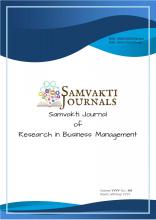+91-9958 726825
The Role of Smartphone in The Future of Technology
|
The usage of the Internet has expanded in recent years with the advent of the World Wide Web. In this article, we show how current advances in technology lead to the creation of a mobile code system and often mobile agents. In this connection, we are addressing some technological and non-technical obstacles. It seems that almost all large websites will be able to host and host some mobile code or mobile agents within a few years. The Internet did not exist forever; it was created by humans in the 1970s and 1980s. Then we saw it growing, attempting to hang on and ensure it continued to run. It appears very obvious that the desire to maintain the Internet is enormous, as long as technology at least continues to be similar to today's level. The Internet is extremely, very helpful. To continue, though, the Internet depends on a lot of technology. We need electricity, computers, semiconductors, applications and a high-tech economy that works.
|
|
With the rapid advancement of computers & networking technologies, combined because of the unprecedented expansion in the amount of On the web, you may get a variety of products and data, we in the near future arrive at a moment at which 100 of billions of individuals will be able to participate easy, always-on With the internet, you have accessibility to a greater quantity of knowledge. their Employment, education, and house are all important factors to consider. desktop computers as well as through their televisions, telephones, pagers, and car dashboards, from a variety of sources. For such access to be made more convenient in the future, Portable coding, and specifically portable users, will be critical.
Brokers on the go programmes that can move from one host to another on a system at their discretion, at as well as at locations of our choice. On May 1, 1999, during the Autonomous "Portable Entities in the Setting of Competitive and Collaboration" is the theme of the Directors' 99 Conference. (MAC3)," the current state of the running programme was stored, transferred Greetings to the hosts organism, and a considerably identical work published as a position paper in the same conference. Copyright remains in the hands of the authors[1]. This information is saved, making it feasible for the programme to pick up wherever it was last seen later. Mobility agency solutions vary from activity migrating platforms in that the users migrate when they select, generally by issuing a "jump" or "go" instruction, but in a procedure migrating computer, the system determines how and where the current program should be transferred. Apps, on the other hand, are applications that are uploaded as a result of a user 's engagement and run on an one site from start to finish, while portable brokers operate on several hosts. Numerous reasons make mobile agents an effective alternative in comparison to the customer model applications, including reductions customer architecture device latency and bandwidth, as well as a reduction in network disconnection vulnerabilities and network disconnection vulnerabilities. Many additional applications will find mobile agents to be the most powerful deployment method, even if not all of their duties will need the use of mobile agents for all or a portion of their tasks. We agree that the use of mobile agents is a result of current advances in internet technology and use, but there are many technological and non-technological barriers that must be overcome along the road to implementation. These roadblocks are significant but not insurmountable obstacles, and we anticipate that mobile agents will be authorized by many major Internet sites within a few years. The aim of this article is to elicit discussion on the most effective means of realizing this lofty, yet achievable, vision[2].
Many trends are influencing the actions of those who use Internet technology, including:
The telecoms sector is now lying asleep massive quantities of fibers optic cable. It is incredible. Despite the fact that The amount of traffic on the web is increasing. rapidly, the amount of Broadband bandwidth accessible infrastructure, as well as the number of workplaces and communities, is huge and will soon be exhausted. Nonetheless, a large number of end consumers of bandwidth would continue to be constrained by a variety of technical reasons. Many customers are still able to connect to the old copper loop through a modem or, at the very least, an ADSL connection. Several additional users may communicate with one another through Wi-Fi connections with limited capacity.
For the most part, Customers may anticipate their desktop computer or palmtop to have only 128 Kbps to 1 Mbps of available bandwidth, although some asymmetric cable modems can deliver speeds of up to 10 Mbps. The distance among the platform's "edge" and low bandwidth and its "backbone,". It has a high bandwidth, will significantly increase since it is beneficial to the foundation improved fiber reliability and accessibility, whereas the competitive advantage continues to be hampered by Wi-Fi and cable networks' basics. Although local connections are expected to grow beyond 1 Mbps in the coming years, we expect this trend to continue, owing to the fact that Bandwidth utilisation on the network are increasing. at a much faster rate than local connection bandwidths. 1.6 Tbps optical-fiber product announced by Nortel, which will be available in 2000, is an example of what is possible[3].
The development of portable computing devices is 1 of the biggest fascinating fields of research research and development in this field of computers. Users will have no idea that their smartphones, palm computers, electronic books, and automobiles, as well as telephones and pagers, will have access to Companies on the web in order to perform user duties, even if they are aware that such access is taking place. Most of the time, those gadgets would having inconsistent, low-quality services capacity, and high-latency connections to the telephone system or even a mobile connection.
First and foremost, make it obvious that the ability to view your email from any device is critical for users. Web computers would becoming more common. ubiquitous in the open places cafes, airlines, and motels, for example as the Internet becomes more accessible. End users would eventually have complete access to their files and programmes from any terminal, which would be especially beneficial given the rise in available bandwidth. Although this is the case, unregulated mobile devices will continue to grow because, like Internet interfaces would ever be accessible alongside open phones. wherever a user may find themselves[4].
Organisations are becoming more diverse. relying on procedures, especially HTTP is used to create private "intranets" for businesses. the distribution of data that they need to maintain control over. All connections to a private network are controlled by a particular group of people. It is possible to implement new technology. more fatly as a result of the fact that (1) there is less need for cooperation with external organizations and (2) there is less worry about security (within the intranet).
Internet users are becoming more dissatisfied with the vast quantity of information accessible, and as the Internet continues to grow, the issue will only worsen. Currently available solutions that enable the client to compress a bittorrent into a streams that can be managed include search engines, shop-bots, emails filters, cooperative filtration, and portal; however, the functionality of these technologies is still severely limited.
In contrast to broadcast media, the Internet allows users to tailor their access according to their preferences. The present state of technology allows for modification on either the customer and as well as the service sides. The ability to customize a website on its own is available on many websites; however, third-party "proxy" services are increasingly offering the customization options[5].
In order to connect 1 or many additional Web service among a client and two or fewer another Web providers, these Tunnel websites, that are the most popular, commonly seen on Web sites nowadays, such as various shop-bots, must be established. When it comes to minimizing information overload while also personalizing gateway, services accessibility sites will become more essential. Due to the increasing prevalence of portable devices, it will be necessary to offer highly specialized proxy sites for the purpose of satisfy the unique mobility capabilities users in particular.
There is a slew of technological obstacles it should be the case overcome because once they can be extensively used, portable agents must first be developed. deployed.
Brokers on the go currently in use at the price of networking speed and capacity increased load on devices that provide services. This is because agents are always written in a (relatively) slowly For mobility and security considerations, translated languages is used, and because Injectable members are required. upon arrival in a suitable execution environment.
As a result, even Portable nodes may operate in the presence of networking interruptions. frequently takes a little more complete much of a work conventional approaches, because the period saved by eliminating networking communication in the middle are Presently, the timing penalty form delayed implementation and excess migration are smaller than the time penalty form worse implementation and overhead migration. [6]. Because of advancements in compiling-at-the-right-moment, isolating programs defects, and other methods, codes for smartphone may now run at speeds that are comparable to native code in terms of performance and efficiency. Furthermore, research organizations are currently focusing their efforts on finding methods to reduce the amount of overhead migration. Together, these efforts may result in a mechanism that accepts and rewards those who agree and reward those who agree and encourage those who agree running a cellphone representative requires just a slightly higher level of especially the servicing equipment was turned on supplied the functionality of the directly as a constructed function constructed process.
Almost All message transfer platforms allow for the creation of a programme to be able to travel easily between For instance, consider diverse computers., by compiling convert the script into a platform-agnostic representations, such as Java byte codes, and then compiling the code into native code or running it within an interpreter when it reaches the target machine. However, in order for mobile agents to be widely utilized, The script has to be correct. adaptable via the usage of While it is a portable device, unrealistic to anticipate programming communities to agree on the basis of an unique portable scheme.
It will require a significant amount of standardization work to ensure that code is portable across platforms. In contrast to the OMG MASIF standard, which deals solely with cross-system communication and administration, this first step leads to an agent that is unable to travel to the intended computer, but only to the nearest device which is in charge of the "correct" network of agents. The broker on the go group should proceed to the subsequent stage in standardising such distinct punishment settings punishment a migrating agent's code and status are encoded. This is a big step forward[7].
When technological obstacles are overcome, there are a number of non-technical problems that must be addressed before mobile-agent technology can be widely used, and they include: A compelling reason must be provided for internet sites Rationalize the action in order to conquer resistance. expense of updating existing mechanisms, and embrace technological advancements.
However, although the technical reasons presented the following are persuasive, It don't exist. adequate for the majority of website managers. In the end, technology will only be used if it results in significant improvements in the end-experience, user's such as more useful apps with faster data accessibility, assistance for detached operations, and related services essential characteristics. Fortunately, many novel methods are now being investigated by several organizations, each of which addresses (or 4 In many cases, when an agent comes from a computer that isn't trusted, the access privileges of the agent are reduced, even if the agent were started by a reputable source site by a trusted user[8]. When visiting an untrusted site, there is a chance that one of these three problems will have been deliberately altered. The present state of research indicates that Proxy technologies for cellular phones would be used. sufficiently reliable for a wide range of operations within a few years, despite the fact that more technical improvements (as well as user education initiatives) are required. |
|
HTML5, the most recent edition of the HTML family of standards, broadens the technology's usefulness by making it more suitable for client-side applications. The aim of HTML5 is to enable the creation of fully functional client-side apps, as opposed to traditional Web applications, which having a greater or lesser amount served for usage as client terminals server-side programmes. The advent of HTML5 therefore enables additional programmes to be executed in the browser, and these apps may be distributed across a network utilizing the standard Web technology frameworks.
Furthermore, while the majority of these apps were frequently networked, and may also be operated in an on-the-go option, and, particularly These were not returned to them following service. necessary reliant on a single server for their operation. For us, the overarching aim of HTML5 is to enable the development of rich apps, and we will not discuss any particular new technology provided by HTML5 in this article[9]. These HTML5 capabilities, combined alongside similar modern changes, like the Internet's growing ubiquitousness and improved The ability to introduce Internet software frameworks and operational system is enabled by the efficiency of Js simulated computers within browser. referred to as " Running system for the internet " – in the future. Applications may be kept in a cache on these systems, preventing them from having to be downloaded again on future calls to the programme. For the user, this means that utilising the apps is no different from using conventional installed software on their computer. Cloudberry, Chrome OS is a Chrome operating system., and Mozilla's Firefox OS are just a few examples of such operating systems. Chromium OS is the most general of these operating systems For internet smartphones, Mozilla OS and Cloudberry are operational platforms whereby all consumer cellphone functions is provided as HTML5 applications. The above-mentioned systems also demonstrate that HTML5 technology may be utilised to develop full and sophisticated programmes that are almost indistinguishable from conventional, installable binary apps in many respects. Web operating systems, on the other hand, differ from traditional application platforms from a technological standpoint because they are based on Web principles rather than running platforms and binaries programs are more established ideas, as is the case with traditional application platforms. However, even while programmes are frequently stored, although typically were not always "installed," and updates may be sent mechanically and with human intervention interfering with the person's perspective experience[10]. The growth of internet- based modes of operation, particularly Cloudberry, has sparked the concept of a cloud-based web browser. The user session in Cloud browser is comprised of a browser session, which is in essence a collection HTML5 & the number of open "sites" apps, both of which are identifiable by their related URLs. It is possible to save a user session – including the URLs of apps and information about their current state – on the Internet. |
|
There is an issue compelling the argument for usage in the field of remote agencies a wide range of Internet-based applications. There is, however, a straightforward We'll be on an evolving route which will lead us from here to there. present from portable codes and agencies to ubiquitous use of technologies over the next several years. After several technical hurdles have been solved and a few forward-thinking sites have used technologies for portable agents, the usage of mobile agents is expected to increase dramatically.
Even when the technological difficulties have been overcome, a number of non-technical issues may persist, which may prevent the broad portable edge technologies acceptance from occurring. Internet sites must be provided with a compelling incentive in order to overcome inertia, justify the expense of upgrading their systems, and adopt new technologies. Despite the fact that the technical arguments outlined Although the arguments presented above are compelling, they are insufficient to the preponderance of site managers. To be successful in obtaining approval for installation, the system must first offer significant improvements to the end-experience. user's This includes more helpful software, each with simple data accessibility, unconnected operations assistance, and other important characteristics |
|
|
Pain Text:
Ms. Anuska Sharma (2021), The Role of Smartphone in The Future of Technology. Samvakti Journal of Research in Information Technology, 2(2) 45 - 53. DoI : 10.46402/2021.02.22
Ms. Anuska Sharma (2021), The Role of Smartphone in The Future of Technology. Samvakti Journal of Research in Information Technology, 2(2) 45 - 53. DoI : 10.46402/2021.02.22





